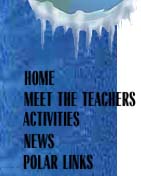
|
Annual Report for Betty Trummel Teacher Info Page | Annual Login Page | Presentations
Continued Collaboration with Reasearch Team Members Type of Interaction / Outcomes / Dates / Locations / Parcticipants: Dr. Ken Verosub and I attended the TEA Orientation at NSF and we were on a panel that shared discussion of TEA/researcher roles and responsiblity. At that time I also met with Dr. Verosub and shared my "Recipe For A Core" activity, based on the Cape Roberts Project. I had forwarded the activity to Dr. Verosub prior to the TEA meeting. I wanted his feedback about the activity.He approved of the core activity and was happy to see that I was having students do measurements and take field notes. It really reflects what scientists did in the core lab each day while in Crary Lab at McMurdo Station. September 6-9, 2000
How are you sharing your research experience with your colleagues, district, community, etc?
1. Presentations
2. Core activity
3. Student-created projects for my Antarctic Resource Trunk
Antarctic Resource Trunk with examples of photos, digital images, journals, etc. from my Antarctic experience
4. Using the TEA web site
5. Classroom displays
TEA Collaborative Learning Group
Name:
Jan Sarbaugh
Active?
Yes
Active?
Yes
Active?
Yes
Number of Associates in local network:
3
Type of Interaction / Outcomes / Dates / Locations / Parcticipants: We had meetings during most months that focused on TEA's in the field, activities (including sharing my core activity), I gave them copies of the TEA web site CD ROM for their class as well as large Antarctica maps, I continually share how I use TEA in my classroom, and we shared ideas for the Antarctic Resource Trunk and its development.
2000-01 school year
Presentations and Real Audio Sessions
Presentation Date, Title, Number of Attendees, Etc.
Location:
Ridgefield-Crystal Lake Presbyterian Church
Type of Presentation:
church youth group
Co-Presenters:
none
Content:
1 hour presentation as part of a youth program. Slides, gear, TEA and Cape Roberts Project.
Outcomes:
At least 2 other presentations were booked as a result of this talk.
Location:
Rockford, Illinois
Type of Presentation:
Phi Delta Kappa (professional educator/administrator organization)
Co-Presenters:
none
Content:
1 1/2 hour presentation including slides, gear, TEA, Cape Roberts, educational outreach activities and ideas,and question/answer period. Very enthusiastic group!
Outcomes:
Several additional presentations resulted from this evening presentation.
Location:
Hebron Elementary School
Type of Presentation:
3rd through 5th grade classes
Co-Presenters:
none
Content:
1 hour presentation including gear, slides, TEA and Cape Roberts Project.
Location:
Crystal Lake, Illinois
Type of Presentation:
Delta Kappa Gamma Society International (key women educators)
Co-Presenters:
none
Content:
1 1/2 hour presentation about TEA, Antarctic experience, educational outreach, and all aspects of my experience.
Outcomes:
Suggestions from this group to apply for a grant to fund an educational outreach project -- Antarctifc trunk of materials -- to travel around Illinois. Will apply for this grant.
Location:
Northern Illinois University, De Kalb, Illinois
Type of Presentation:
Science Methods Course (I am the instructor)
Co-Presenters:
none
Content:
This was a 3 hour presentation to elementary education majors, all a semester away from student teaching. I feel that it is important to share excellent programs like TEA with preservice teachers, to have them become familiar with programs they might get involved with when they have their own class.
Students had a lengthy assignment prior to my presentation to familiarize them with the TEA website. They were required to read journal entries, explore the purpose of TEA and learn about other teachers who are involved with the program.
My talk covered TEA and TEA Associates, slides of my experience, educaitonal outreach, ECW gear, the TEA website, activites and classroom suggestions, and much more.
Outcomes:
One student (an older one) chose to become a TEA Associate as a result of this presentation.
Have you presented to your local board of education this year?
Yes
Title:
Recipe For A Core
Description:
Has this activity been submitted to the TEA Web Site?
No
Title:
Creating An Educational Kit To Share
Description:
Has this activity been submitted to the TEA Web Site?
No
Has this activity been submitted to the TEA Web Site?
No
TEA Orientation March and August 2000, partnered with Bruce Smith and Sharon Harris throughout their experience. Also in contact with Joanna Hubbard. New TEA's...actively engaged with Kolene Krysl and most recently Tina King are communicating regularly. ECW gear monitoring; booth hosting at NSTA in Orlando; TEA Activities Workshop in July 2000; Ed Board Proposals: 3 for NSTA in St. Louis; 3 grant proposals for Antarctic Trunks; 1 for Illinois Science Teachers Association Convention (Oct. 2000); 1 for NSTA regional convention in Milwaukee (Oct. 2000); 2 for NSTA regional convention in Salt Lake City (Oct. 2001)
Have you submitted all press-related materials concerning your TEA experience to the TEA Archives?
Yes
Have you submitted 20 digital images to the TEA Archive with electronic captions?
Yes
Have you submitted 6-8 photos to the TEA Arichive?
Yes
Number of Release Days Covered by School/District for TEA Program/Activities:
8
Dates:
Jan. 21, Feb. 15, March 23, April 6-7 & 20, October 20 & 27
Reasons for Release:
presentations, workshops, ISTA, NSTA
Approximate Daily Rate of Substitute and Number of Substitute Days:
$75.00
TEA Meetings Covered by School/District/Corporation
Permanent Materials and Equipment Provided by Institution/Corporation/District for the TEA Program
Type of Grant / Grant Title:
Antarctic Resource Trunks
Purpose of Grant:
educational outreach/sharing materials
Granting Institution/Corporation/District:
Lambda State Foundation For Educational Studies
Date of Application:
May 2000
Date of Notification:
July 2000
Grant Total:
$2,000.00
Other Shared Costs
NSTA St. Louis -- 3 presentations accepted and short course; in charge of booth and booth duties;
TEA orientation in August (CRREL); ECW gear coordinator; local/state/national presentations
|
